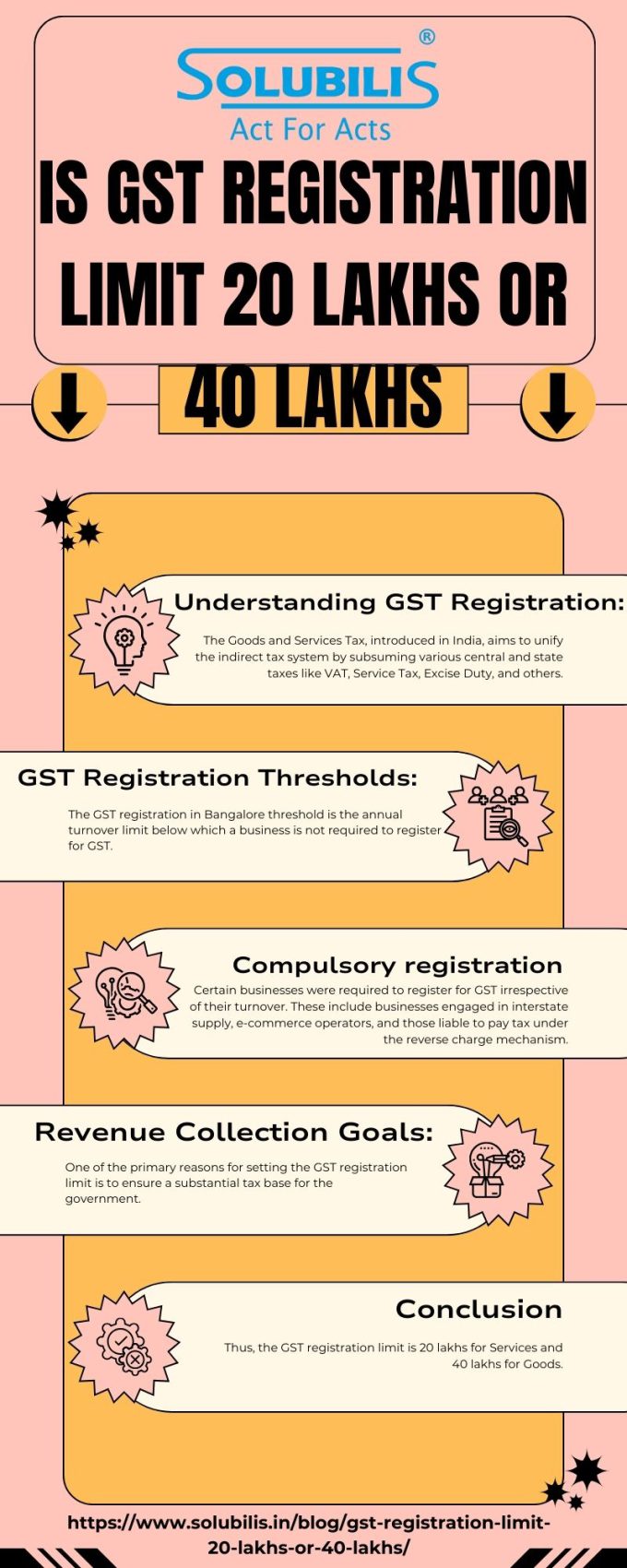Is GST registration limit 20 lakhs or 40 lakhs

The Goods and Services Tax (GST) registration limit in India has been a subject of frequent changes and adjustments since its implementation on July 1, 2017. As of update in January 2022, the threshold for GST registration was primarily set at 20 lakhs INR of annual turnover, with some exceptions and variations depending on the type of business and the state in which it operates. However, it’s essential to note that tax laws can change, and I recommend verifying the current threshold with the latest information from the official GST website or a tax professional. In this blog, I will provide an overview of the GST registration limit, its significance, and the factors that influence it.
Understanding GST Registration:
The Goods and Services Tax, introduced in India, aims to unify the indirect tax system by subsuming various central and state taxes like VAT, Service Tax, Excise Duty, and others. GST is a destination-based tax, levied at each stage of the supply chain, from manufacturing to the final consumption of goods and services. The GST registration is mandatory for businesses exceeding a specified annual turnover threshold, and they are required to collect GST from customers and remit it to the government.
GST Registration Thresholds:
The GST registration in Bangalore threshold is the annual turnover limit below which a business is not required to register for GST. As of the last update, the GST registration thresholds in India were as follows:
20 Lakhs for Most States:
In most states and Union Territories, businesses with an annual turnover of 20 lakhs or more were required to register for GST. This threshold is applicable to both goods and services.
10 Lakhs for Special Category States:
In special category states, including the north-eastern states and some hilly regions, the threshold was lower, set at 10 lakhs for GST registration. This was implemented to support businesses in economically disadvantaged areas.
Compulsory Registration:
Certain businesses were required to register for GST irrespective of their turnover. These include businesses engaged in interstate supply, e-commerce operators, and those liable to pay tax under the reverse charge mechanism.
Factors Influencing GST Registration Limit:
Several factors influence the determination of the GST registration in Bangalore limit, and these are subject to change based on government policies and economic conditions. Here are some of the key factors:
Revenue Collection Goals:
One of the primary reasons for setting the GST registration limit is to ensure a substantial tax base for the government. By exempting smaller businesses, the government can focus its efforts on larger businesses that contribute significantly to the tax revenue.
Promoting Small Businesses:
Lower GST registration in Bangalore thresholds in special category states are aimed at promoting and supporting small and medium-sized businesses in economically disadvantaged areas. This can stimulate economic growth and employment opportunities in these regions.
Ease of Compliance:
Setting a threshold helps reduce the compliance burden on small businesses. Registering for GST involves maintaining records, filing returns, and remitting taxes. By exempting small businesses, the government aims to ease the administrative burden on these enterprises.
Preventing Tax Evasion:
On the flip side, a higher registration threshold can potentially encourage tax evasion as smaller businesses may attempt to remain below the threshold to avoid obligations of GST that can get GST registration in Bangalore. Therefore, the government must strike a balance between supporting small businesses and preventing tax evasion.
Economic Conditions:
Economic conditions, such as inflation and changes in the cost of living, can impact the GST registration threshold. In some cases, the government may adjust the threshold to account for changes in the business environment.
Impact of GST Registration Limit:
The GST registration limit has a significant impact on businesses, tax collection, and the overall economy. Let’s explore these effects in more detail:
Compliance and Administration:
Businesses that cross the GST registration threshold must comply with the GST regulations, which include maintaining detailed records, filing regular returns, and collecting and remitting GST. This can be administratively burdensome for businesses.

Tax Revenue:
The GST registration threshold directly affects tax revenue. By exempting smaller businesses, the government may miss out on potential tax collections. Conversely, a lower threshold can help capture a larger tax base.
Competitive Landscape:
The threshold can influence the competitive landscape. Smaller businesses that d not have GST registration in Bangalore may have a pricing advantage over registered businesses, as they do not have to charge GST on their products or services.
Business Growth:
The threshold can impact the growth of businesses. Businesses nearing the threshold may have to carefully manage their turnover to avoid registration. Conversely, those just below the threshold may aim to cross it to claim input tax credit.
Consumer Prices:
GST is typically passed on to the end consumer. A lower threshold may result in more businesses charging GST, which could lead to higher prices for consumers. Conversely, a higher threshold may keep prices lower.
Changing GST Registration Limit:
The GST registration in Bangalore limit has not remained static since its introduction. The government has made adjustments based on various factors. Changes to the threshold are typically introduced through the annual budget or by GST Council recommendations. Here are some instances of changes in the GST registration limit:
2017-2018: The GST registration threshold was initially set at 20 lakhs for most states and 10 lakhs for special category states when GST was launched in 2017.
2019-2020: In response to demands from small businesses, the GST Council increased the threshold to 40 lakhs for most states and 20 lakhs for special category states, providing relief to a significant number of small businesses.
2020-2021: In light of the COVID-19 pandemic’s economic impact, the government temporarily increased the GST registration threshold for small businesses from 40 lakhs to 1.5 crores. This measure aimed to provide relief to businesses during challenging times.
Future Adjustments: The GST registration threshold may continue to evolve based on economic conditions, revenue targets, and government policy decisions. It’s essential for businesses to stay updated with the latest announcements.
Impact on Different Sectors:
The impact of the GST registration in Bangalore limit varies across sectors. Here’s a brief overview of how different sectors are affected:
Manufacturing and Trading: Manufacturing and trading businesses typically have a significant turnover. A higher registration threshold can benefit smaller players in these sectors, reducing their compliance burden.
Services: Service-oriented businesses often have lower turnover compared to trading and manufacturing. They might find it more manageable to stay below the threshold. A higher threshold benefits these businesses.
E-commerce: E-commerce operators and sellers are subject to specific GST rules. Many e-commerce sellers operate on thin margins, and the threshold adjustments can significantly impact their GST obligations.
Agriculture: Small and marginal farmers and rural businesses may benefit from a higher threshold, as their annual turnover tends to be lower.
Conclusion:
Thus, the GST registration limit is 20 lakhs for Services and 40 lakhs for Goods. For GST registration & Filing, contact Solubilis. We offer services at an affordable cost.

